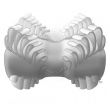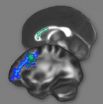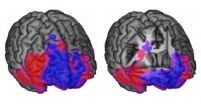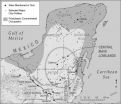(Press-News.org) TORONTO, ON – The radula sounds like something from a horror movie – a conveyor belt lined with hundreds of rows of interlocking teeth. In fact, radulas are found in the mouths of most molluscs, from the giant squid to the garden snail. Now, a "prototype" radula found in 500-million-year-old fossils studied by University of Toronto graduate student Martin Smith, shows that the earliest radula was not a flesh-rasping terror, but a tool for humbly scooping food from the muddy sea floor.
The Cambrian animals Odontogriphus and Wiwaxia might not have been much to look at – the former a naked slug, the latter a creeping bottom-dweller covered with spines and scales. Despite the hundreds of fossil specimens collected from the Canadian Rockies by the Royal Ontario Museum, scientists could not agree whether they represented early molluscs, relatives of the earthworm, or an evolutionary dead-end. Smith, a PhD candidate in Uof T's Department of Ecology and Evolutionary Biology and author of a study published this week in Proceedings of the Royal Society B, employed a new, non-destructive type of Electron Microscopy to reveal the new details.
"I put the fossils in the microscope, and the mouth parts just leaped out," says Smith, a PhD candidate in U of T's Department of Ecology and Evolutionary Biology. "You could see details you'd never guess were there if you just had a normal microscope."
After examining some 300 fossils, Smith was able not just to reconstruct the mouthparts, but work out how they grew. "The fossils are squashed completely flat, which makes them really hard to reconstruct in 3D," says Smith. "I surrounded myself with micrographs of the mouth parts and lumps of plasticine, and spent weeks trying to come up with a model that made sense of the fossils."
The new observations demonstrated that the mouthparts consisted of two to three rows of 17 similarly-shaped teeth, with a symmetrical central tooth and smaller teeth on the edges. The teeth would have moved round the end of a tongue in the conveyor-belt fashion seen in molluscs today, scooping food – algae or detritus – from the muddy sea floor. By establishing how the teeth were arranged, moved, grew, and were replaced, Smith was able to demonstrate that they formed a shorter and squatter forerunner to the modern radula.
"When I set out, I just hoped to be a bit closer to knowing what these mysterious fossils were," says Smith. "Now, with this picture of the earliest radula, we are one step closer to understanding where the molluscs came from and how they became so successful today."
The findings are reported this week in the paper "Mouthparts of the Burgess Shale fossils Odontogriphus and Wiwaxia: implications for the ancestral molluscan radula".
INFORMATION:
MEDIA CONTACTS:
Martin Smith
Department of Ecology and Evolutionary Biology
University of Toronto
+44 1223 333452 (office)
+44 7743 537 510 (cell)
ms609@cam.ac.uk
Sean Bettam
Communications, Faculty of Arts & Science
University of Toronto
416-946-7950
s.bettam@utoronto.ca
Ancient fossils reveal how the mollusc got its teeth
2012-08-22
ELSE PRESS RELEASES FROM THIS DATE:
UCI microbiologists find new approach to fighting viral illnesses
2012-08-22
Irvine, Calif., Aug. 22, 2012 — By discovering how certain viruses use their host cells to replicate, UC Irvine microbiologists have identified a new approach to the development of universal treatments for viral illnesses such as meningitis, encephalitis, hepatitis and possibly the common cold.
The UCI researchers, working with Dutch colleagues, found that certain RNA viruses hijack a key DNA repair activity of human cells to produce the genetic material necessary for them to multiply.
For many years, scientists have known that viruses rely on functions provided by ...
Australian general practitioners in training spend less time with peds patients than with adults
2012-08-22
Ann Arbor, Mich. — Australian doctors-in-training spend significantly less time consulting with pediatric patients than they do with adults, according to a new study published in the journal Australian Family Physician.
The study found that the proportion of longer consultations – more than 20 minutes -- for children was significantly less than that for adults and seniors among general practice registrars, says Gary Freed, M.D., M.P.H., the lead author on the study and Australian-American health policy fellow, Australian Health Workforce Institute at the University of ...
Close contact with young people at risk of suicide has no effect
2012-08-22
Researchers, doctors and patients tend to agree that during the high-risk period after an attempted suicide, the treatment of choice is close contact, follow-up and personal interaction in order to prevent a tragic repeat. Now, however, new research shows that this strategy does not work. These surprising results from Mental Health Services in the Capital Region of Denmark and the University of Copenhagen have just been published in the British Medical Journal.
Researchers from Mental Health Services in the Capital Region of Denmark and the University of Copenhagen have ...
Rewired visual input to sound-processing part of the brain leads to compromised hearing
2012-08-22
ATLANTA – Scientists at Georgia State University have found that the ability to hear is lessened when, as a result of injury, a region of the brain responsible for processing sounds receives both visual and auditory inputs.
Yu-Ting Mao, a former graduate student under Sarah L. Pallas, professor of neuroscience, explored how the brain's ability to change, or neuroplasticity, affected the brain's ability to process sounds when both visual and auditory information is sent to the auditory thalamus.
The study was published in the Journal of Neuroscience.
The auditory thalamus ...
Intense prep for law school admission test alters brain structure
2012-08-22
Intensive preparation for the Law School Admission Test (LSAT) actually changes the microscopic structure of the brain, physically bolstering the connections between areas of the brain important for reasoning, according to neuroscientists at the University of California, Berkeley.
The results suggest that training people in reasoning skills – the main focus of LSAT prep courses – can reinforce the brain's circuits involved in thinking and reasoning and could even up people's IQ scores.
"The fact that performance on the LSAT can be improved with practice is not new. ...
Study shows long-term effects of radiation in pediatric cancer patients
2012-08-22
For many pediatric cancer patients, total body irradiation (TBI) is a necessary part of treatment during bone marrow transplant– it's a key component of long term survival. But lengthened survival creates the ability to notice long term effects of radiation as these youngest cancer patients age. A University of Colorado Cancer Center study recently published in the journal Pediatric Blood & Cancer details these late effects of radiation.
"These kids basically lie on a table and truly do get radiation from head to toe. There is a little blocking of the lungs, but nothing ...
New laboratory test assesses how DNA damage affects protein synthesis
2012-08-22
RIVERSIDE, Calif. — Transcription is a cellular process by which genetic information from DNA is copied to messenger RNA for protein production. But anticancer drugs and environmental chemicals can sometimes interrupt this flow of genetic information by causing modifications in DNA.
Chemists at the University of California, Riverside have now developed a test in the lab to examine how such DNA modifications lead to aberrant transcription and ultimately a disruption in protein synthesis.
The chemists report that the method, called "competitive transcription and adduct ...
NASA sees an active tropical Atlantic again
2012-08-22
The Atlantic Ocean is kicking into high gear with low pressure areas that have a chance at becoming tropical depressions, storms and hurricanes. Satellite imagery from NASA's Terra and Aqua satellites have provided visible, infrared and microwave data on four low pressure areas. In addition, NASA's GOES Project has been producing imagery of all systems using NOAA's GOES-13 satellite to see post-Tropical Storm Gordon, Tropical Depression 9, and Systems 95L and 96L.
Tropical Storm Gordon is no longer a tropical storm and is fizzling out east of the Azores. Tropical Depression ...
Thinking and choosing in the brain
2012-08-22
PASADENA, Calif.—The frontal lobes are the largest part of the human brain, and thought to be the part that expanded most during human evolution. Damage to the frontal lobes—which are located just behind and above the eyes—can result in profound impairments in higher-level reasoning and decision making. To find out more about what different parts of the frontal lobes do, neuroscientists at the California Institute of Technology (Caltech) recently teamed up with researchers at the world's largest registry of brain-lesion patients. By mapping the brain lesions of these patients, ...
Multiple factors, including climate change, led to collapse and depopulation of ancient Maya
2012-08-22
TEMPE, Ariz. — A new analysis of complex interactions between humans and the environment preceding the 9th century collapse and abandonment of the Central Maya Lowlands in the Yucatán Peninsula points to a series of events — some natural, like climate change; some human-made, including large-scale landscape alterations and shifts in trade routes — that have lessons for contemporary decision-makers and sustainability scientists.
In their revised model of the collapse of the ancient Maya, social scientists B.L. "Billie" Turner and Jeremy "Jerry" A. Sabloff provide an up-to-date, ...





